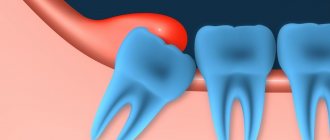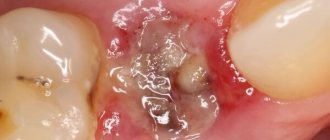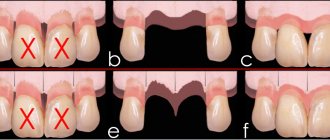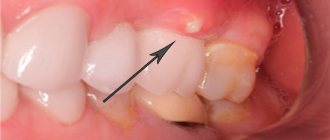Date of publication: 26-11-2020 Date of update: 19-03-2021
At the Clarimed clinic, we perform painless tooth hood removal 24 hours a day.
Nowadays, wisdom teeth are vestigial organs - in 20% of the world's population they either do not form or have developmental delays.
Usually the third molars simply do not come out of the gums, hiding behind the hood, or they come out partially. In this case, the hood is the mucous tissue covering the gum and the unformed rudiment. It is not airtight - bacteria, food debris and saliva get under it, which can result in rotting, the development of an infectious disease or caries on the molars.
You can determine that an infection has developed under the mucous membrane either by the appearance of swelling (swelling of not only the gums, but also the cheeks is possible), bad breath and the sensation of a foreign body under the hood. As a form of prevention and treatment, a surgical operation is performed to remove the hood of a wisdom tooth: the dentist removes excess mucous membrane, forming an open space around the tooth.
Indications for gum excision
Indications for wisdom tooth removal under the hood
relate:
- The presence of swelling in the cheeks and gums.
- Painful sensations.
- The appearance of lymph nodes.
- Pain when swallowing.
- Increased body temperature.
- Discomfortable sensations when opening the mouth.
Such symptoms should never be ignored. If the patient has indications for wisdom tooth hood removal,
you need to consult a doctor.
Such symptoms should never be ignored. Further spread of the inflammatory process threatens inpatient surgical treatment. Therefore, it is necessary to urgently consult a doctor and remove the tooth hood.
Symptoms of pericoronitis
Determining pericoronitis is not very difficult; let’s look at the main signs of the disease:
- Pain in the area of a tooth that is in the process of erupting;
- A noticeable inflammatory process, manifested by redness of the mucous tissues;
- Swelling of the gums in the area of the causative tooth;
- Unpleasant sensations in the area of inflamed gums;
- An unpleasant odor emanates from the tooth due to the pus formed in the hood.
If the signs of pericoronitis are not eliminated in time by cutting the hood, minor symptoms can develop into more serious ones. Over time, it may become more difficult for a person to chew food, as swelling can spread to the muscles of mastication, making it difficult to eat. Additionally, it may become much more difficult for the patient to open and close their mouth due to severe swelling. Acute inflammation can also cause high fever.
If you notice similar symptoms, we recommend that you immediately contact professional and experienced dentists. The infiltrate contained in the hood can develop into an abscess, and rupture of the capsule can lead to phlegmon.
You can make an appointment with a doctor at the Ilatan Clinic by calling the numbers listed on the website. The administrator will schedule you for an initial consultation. The doctor will conduct a thorough examination of your mouth. Make a final diagnosis and determine the stage of the disease. After all the necessary diagnostic measures, the doctor, if necessary, will prescribe you a procedure to remove the hood over the wisdom tooth. In some cases, removal of the entire wisdom tooth is prescribed if it is not of significant value. In addition, such a decision will be made if the x-ray shows that there is not enough space for the tooth in the mouth or if it is growing incorrectly.
It should be noted that the operation to excise the hood over a wisdom tooth is not considered difficult, so the use of local painkillers will be sufficient.
Progress of the procedure
Removing a wisdom tooth hood is not particularly difficult for either the doctor or the patient. The procedure takes a short period of time and causes virtually no inconvenience to the patient. After it is carried out, the tissue heals quickly, and the cavity around the tooth disappears.
Sequence of actions when removing the hood:
- an injection with an anesthetic is given at the excision site;
- cut out part of the tissue that hangs over the wisdom tooth;
- treat the excision site with an antiseptic;
- medicine is applied.
After the wisdom tooth hood is removed, the patient can go home. A control appointment is usually scheduled after 2–3 days.
In some cases, a situation arises that, despite excision, the hood is formed again, and this process can last quite a long time, repeating from time to time. Then the doctor will most likely recommend removing the wisdom tooth.
Removing a hood over a wisdom tooth
If such a situation is left unattended, the consequences may not be the most pleasant. Food may begin to clog into the free space between the crown of the tooth and the marginal area of the mucous membrane, and it may simply be impossible to clean it with a toothbrush. In this case, it is recommended to immediately contact a specialist to carry out a procedure to excise the gingival hood over the wisdom tooth. If this is not done, then favorable conditions for the proliferation of microbes and bacteria may form in the hood, which will quickly lead to an inflammatory process.
The inflammatory process in the hood above the wisdom tooth is called pericoronitis.
What to do after the procedure
The healing process will largely depend on how the patient takes care of the oral cavity and teeth in the days following the removal of the hood.
- During the first hours after the procedure, it is not recommended to eat or drink.
- Within 24 hours after removal, solid foods should be excluded from the diet. Until the wound heals completely, you need to chew food on the other side of the mouth.
- You need to take care of your oral cavity very carefully, use rinsing, and be extremely careful when brushing your teeth so as not to injure the site of the hood excision.
- In addition to medications prescribed by the doctor, cold is indicated on the side where the hood was.
- To prevent the development of the inflammatory process, overheating (hot food, bath) should be avoided.
Pericoronitis
A complication that occurs in the form of a hood hanging over the wisdom tooth.
The wisdom tooth is the last one to erupt when the jaw is fully formed, its bite is already fully formed and the entire dental arch is filled with teeth. There is simply no room for the growth and development of the figure eight, which leads to abnormal growth of the wisdom tooth:
- the tooth may grow into the jaw;
- implanted into the gum tissue;
- A hood appears over the tooth due to the fact that it has grown into the gum.
The hood appears due to the fact that the figure eight erupts unevenly, and only the small upper part of the crown, which begins to put pressure on the gum, begins to hang over the tooth.
At first, the hood does not bother you at all, but after a while, when food debris and saliva accumulate under it, they begin to decompose. That’s when the hood becomes the cause of the inflammatory process and the acid-base balance is disturbed.
This inflammation is called pericoronitis. It is expressed as follows:
- The gums are swollen.
- Swallowing is difficult.
- There is an unpleasant odor from the mouth.
- Your temperature may rise.
- Headache.
- Swelling of the face appears.
You cannot self-medicate. At the first sign of gum inflammation, you should contact your dentist, who will prescribe treatment. The sooner you visit a doctor, the sooner you will cure the disease. You need to know that the infection spreads quickly, so you can infect the masticatory muscles, which will hurt when chewing food.
At the acute stage of the disease, surgical intervention is required, sometimes complex treatment in a hospital setting. First, a course of therapeutic treatment with antibiotics is prescribed to destroy pathogenic organisms. If treatment does not give a positive result, then surgery is prescribed.
Final provisions
When a doctor diagnoses pericoronitis, it means that the gums around the erupting teeth - permanent or baby - have become inflamed, and the tooth is probably not growing properly. The abnormality creates a pocket called a hood between the new tooth and the soft tissue. The cavity quickly fills with a substrate consisting of plaque and bacteria, and decay begins. The main symptom is pain at the site of the growing tooth; in addition, other signs are present.
Pericoronitis is treated by removing the inflamed soft tissue (hood), or extracting the tooth (in extreme cases). Home methods, rinses, lotions will not help, they can only do harm if you rely on them completely and do not visit the hospital.
Treatment of pericoronitis can be quick - in the early stages, and long and painful - in advanced stages. A person can prevent the development of pathology while complying with hygiene standards. And it is worth remembering that modern dentistry is a very rapidly developing branch of medicine. Trust the professionals to help you maintain your health.
Cervical caries on the front teeth: causes and treatment
Treatment of dental caries using the Icon method without preparation
Dental treatment without a drill, placing a filling without drilling in Moscow
Restoration of tooth enamel, price, drugs
Treat or remove wisdom tooth pulpitis
Mistakes and complications in the treatment of dental pulpitis
Retreatment of tooth canals before prosthetics, with granuloma, cyst and aching pain
Treatment methods for pericoronitis
After a diagnosis has been made and the doctor has confirmed the presence of the disease, the optimal treatment option is selected. The choice of treatment method depends on the degree of tissue damage in the oral cavity. Two surgical treatment options are used: excision of the hood formed over the erupting tooth and removal of the problematic tooth.
Any conservative methods and traditional methods of treatment can reduce pain, but with their help pericoronitis cannot be cured. Without treatment, inflammation inevitably becomes chronic; in the future, a person is faced with the need for more serious manipulations to treat complications.
How is the hood excision procedure performed?
Before the operation, the patient's medical history is collected to find out all possible health problems that may affect the course of treatment. You should definitely tell your doctor about diabetes or cardiovascular diseases, as well as hepatitis and AIDS - these diseases can significantly complicate the rehabilitation process.
Excision of the hood is the most common method of getting rid of pericoronitis, which is used in modern dentistry. The operation is virtually painless, and recovery after surgery does not take much time. The effectiveness of the operation is quite high; it allows you to get rid of the problem forever and at the same time preserve a healthy tooth.
Stages of the operation:
- Administration of local anesthesia.
- Cutting the hood with a scalpel.
- Washing the wound with antiseptic solutions.
- Sutures and bandages.
If after excision of the hood a new hood is formed, then excision again will be pointless. In this case, the problematic tooth is removed to get rid of pericoronitis and avoid serious complications. This happens quite rarely; as a rule, excision of the hood during pericoronitis is effective, and the inflammatory process does not develop again.









